
List of Antarctic territorial claims
Encyclopedia
Seven states maintain a territorial claim on eight territories in Antarctica. These countries have tended to site their scientific observation and study facilities in Antarctica within their claimed territory.
It is sometimes said that the Antarctic Treaty
defers or suspends these claims. However, Article IV(2) states that it does not affect (neither confirm not deny) existing claims: “No acts or activities taking place while the present Treaty is in force shall constitute a basis for asserting, supporting or denying a claim to territorial sovereignty in Antarctica. No new claim, or enlargement of an existing claim, to territorial sovereignty shall be asserted while the present Treaty is in force.”
parallel before 1961. These claims have been recognized only between the countries making claims in the area. All claim areas are sectors, with the exception of Peter I Island
. None of these claims have an indigenous population. The South Orkney Islands
fall within the territory claimed by Argentina and United Kingdom; and the South Shetland Islands
fall within the areas claimed by Argentina, Chile, and the United Kingdom. The UK, France, Australia, New Zealand and Norway all recognize each others' claims, which do not overlap. Prior to 1962, British Antarctic Territory was a dependency of the Falkland Islands
and also included South Georgia and the South Sandwich Islands
. The Antarctic areas became a separate overseas territory following the ratification of the Antarctic Treaty. South Georgia and the South Sandwich Islands remained a dependency of the Falkland Islands until 1985 when they too became a separate overseas territory.
(as successor state
of the Soviet union
) have claimed to have reserved rights on claim and there have also been speculations on Brazil
making a claim bounded by 53° W
and 28° W
, overlapping thus with the Argentine and British claims but not with the Chilean.
are sometimes associated with the continent of Antarctica. None of these territories has an indigenous population.
Bouvet Island
(Norwegian
dependency)
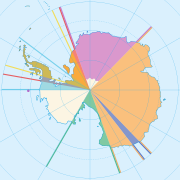 The Antarctic Treaty and related agreements regulate international relations
The Antarctic Treaty and related agreements regulate international relations
with respect to Antarctica, Earth
's only continent
without a native human population. The treaty has now been signed by 46 countries, including the United Kingdom, the United States, and the now-defunct Soviet Union
. The treaty set aside Antarctica as a scientific preserve, established freedom of scientific investigation and banned military activity on that continent
. This was the first arms control
agreement established during the Cold War
. The Soviet Union and the United States both filed reservations against the restriction on new claims, and the United States and Russia
assert their right to make claims in the future if they so choose. Brazil
maintains the Comandante Ferraz
(the Brazilian Antarctic Base) and has proposed a theory to delimiting territories using meridians, which would give it and other countries a claim. In general, territorial claims below the 60° S
parallel have only been recognised among those countries making claims in the area. However, claims are often indicated on maps of Antarctica - this does not signify de jure recognition.
All claim areas except Peter I Island
are sectors, the borders of which are defined by degrees of longitude
. In terms of latitude
, the northern border of all sectors is the 60° S parallel which does not cut through any piece of land, continent or island, and is also the northern limit of the Antarctic Treaty. The southern border of all sectors collapses in one point, the South Pole
. Only the Norwegian sector is an exception: the original claim of 1930 did not specify a northern or a southern limit, so that its territory is only defined by eastern and western limits.
The Antarctic Treaty states that contracting to the treaty:
What the treaty does affect are new claims:
It is sometimes said that the Antarctic Treaty
Antarctic Treaty System
The Antarctic Treaty and related agreements, collectively called the Antarctic Treaty System or ATS, regulate international relations with respect to Antarctica, Earth's only continent without a native human population. For the purposes of the treaty system, Antarctica is defined as all of the land...
defers or suspends these claims. However, Article IV(2) states that it does not affect (neither confirm not deny) existing claims: “No acts or activities taking place while the present Treaty is in force shall constitute a basis for asserting, supporting or denying a claim to territorial sovereignty in Antarctica. No new claim, or enlargement of an existing claim, to territorial sovereignty shall be asserted while the present Treaty is in force.”
Antarctic territorial claims
Seven sovereign states had made eight territorial claims to land in Antarctica below the 60° S60th parallel south
The 60th parallel south is a circle of latitude that is 60 degrees south of the Earth's equatorial plane. No land lies on the parallel—it crosses nothing but ocean...
parallel before 1961. These claims have been recognized only between the countries making claims in the area. All claim areas are sectors, with the exception of Peter I Island
Peter I Island
Peter I Island is an uninhabited volcanic island in the Bellingshausen Sea, from Antarctica. It is claimed as a dependency of Norway, and along with Queen Maud Land and Bouvet Island comprises one of the three Norwegian dependent territories in the Antarctic and sub-Antarctic. Peter I Island is ...
. None of these claims have an indigenous population. The South Orkney Islands
South Orkney Islands
The South Orkney Islands are a group of islands in the Southern Ocean, about north-east of the tip of the Antarctic Peninsula. They have a total area of about ....
fall within the territory claimed by Argentina and United Kingdom; and the South Shetland Islands
South Shetland Islands
The South Shetland Islands are a group of Antarctic islands, lying about north of the Antarctic Peninsula, with a total area of . By the Antarctic Treaty of 1959, the Islands' sovereignty is neither recognized nor disputed by the signatories and they are free for use by any signatory for...
fall within the areas claimed by Argentina, Chile, and the United Kingdom. The UK, France, Australia, New Zealand and Norway all recognize each others' claims, which do not overlap. Prior to 1962, British Antarctic Territory was a dependency of the Falkland Islands
Falkland Islands
The Falkland Islands are an archipelago in the South Atlantic Ocean, located about from the coast of mainland South America. The archipelago consists of East Falkland, West Falkland and 776 lesser islands. The capital, Stanley, is on East Falkland...
and also included South Georgia and the South Sandwich Islands
South Georgia and the South Sandwich Islands
South Georgia and the South Sandwich Islands is a British overseas territory and overseas territory of the European Union in the southern Atlantic Ocean. It is a remote and inhospitable collection of islands, consisting of South Georgia and a chain of smaller islands, known as the South Sandwich...
. The Antarctic areas became a separate overseas territory following the ratification of the Antarctic Treaty. South Georgia and the South Sandwich Islands remained a dependency of the Falkland Islands until 1985 when they too became a separate overseas territory.
Official claims
| Territory | Claimant | Date | Claim limits | |||
|---|---|---|---|---|---|---|
 |
British Antarctic Territory British Antarctic Territory The British Antarctic Territory is a sector of Antarctica claimed by the United Kingdom as one of its 14 British Overseas Territories. It comprises the region south of 60°S latitude and between longitudes and , forming a wedge shape that extends to the South Pole... |
 United Kingdom United Kingdom |
1908 | 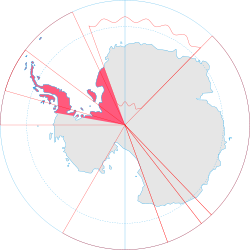 |
||
| (Overseas territory of the United Kingdom) | ||||||
 |
Ross Dependency Ross Dependency The Ross Dependency is a region of Antarctica defined by a sector originating at the South Pole, passing along longitudes 160° east to 150° west, and terminating at latitude 60° south... |
 New Zealand New Zealand |
1923 | 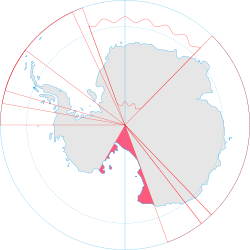 |
||
| (Dependency of New Zealand New Zealand New Zealand is an island country in the south-western Pacific Ocean comprising two main landmasses and numerous smaller islands. The country is situated some east of Australia across the Tasman Sea, and roughly south of the Pacific island nations of New Caledonia, Fiji, and Tonga... ) |
||||||
 |
Adélie Land Adélie Land Adélie Land is the portion of the Antarctic coast between 136° E and 142° E , with a shore length of 350 km and with its hinterland extending as a sector about 2,600 km toward the South Pole. It is claimed by France as one of five districts of the French Southern and Antarctic Lands, although not... |
 Early Modern France Early Modern France |
1924 | 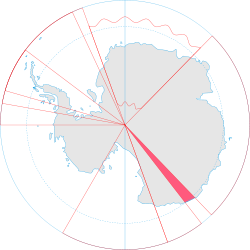 |
||
| (District of French Southern and Antarctic Lands) | ||||||
 |
Peter I Island Peter I Island Peter I Island is an uninhabited volcanic island in the Bellingshausen Sea, from Antarctica. It is claimed as a dependency of Norway, and along with Queen Maud Land and Bouvet Island comprises one of the three Norwegian dependent territories in the Antarctic and sub-Antarctic. Peter I Island is ... |
 Norway Norway |
1929 |  |
68°50′S 90°35′W | |
| (Dependency of Norway) | ||||||
 |
Australian Antarctic Territory Australian Antarctic Territory The Australian Antarctic Territory is a part of Antarctica. It was claimed by the United Kingdom and placed under the authority of the Commonwealth of Australia in 1933. It is the largest territory of Antarctica claimed by any nation... |
 Australia Australia |
1933 |  |
||
| (External territory of Australia) | ||||||
 |
Queen Maud Land Queen Maud Land Queen Maud Land is a c. 2.7 million-square-kilometre region of Antarctica claimed as a dependent territory by Norway. The territory lies between 20° west and 45° east, between the British Antarctic Territory to the west and the Australian Antarctic Territory to the east. The latitudinal... |
 Norway Norway |
1939 | 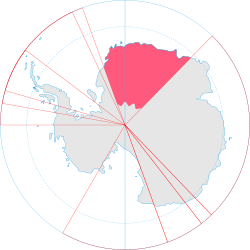 |
||
| (Dependency of Norway) | ||||||
 |
Chilean Antarctic Territory Antártica The Chilean Antarctic Territory is the territory in Antarctica claimed by Chile. The Chilean Antarctic Territory ranges from 53°W to 90°W and from the South Pole to 60°S, partially overlapping Argentine and British Antarctic claims... |
 Chile Chile |
1940 |  |
||
| (Commune of Antártica Chilena Province Antártica Chilena Province Antártica Chilena Province is the southernmost and one of four provinces in Chile's southernmost region, Magallanes and Antártica Chilena Region . The capital is Puerto Williams... ) |
||||||
 |
Argentine Antarctica Argentine Antarctica Argentine Antarctica is a sector of Antarctica claimed by Argentina as part of its national territory. The Argentine Antarctic region, consisting of the Antarctic Peninsula and a triangular section extending to the South Pole, is delimited by the 25° West and 74° West meridians and the 60° South... |
 Argentina Argentina |
1942 | 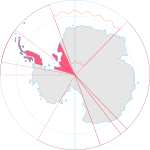 |
||
| (Department Departments of Argentina Departments form the second level of administrative division in the provinces of Argentina. There are no departments in the city of Buenos Aires, which has so far been divided into neighbourhoods as its administrative divisions, but is to be divided now into communes by a recently passed local act... of the province Provinces of Argentina Argentina is subdivided into twenty-three provinces and one autonomous city... of Tierra del Fuego, Antarctica, and South Atlantic Islands Tierra del Fuego Province (Argentina) Tierra del Fuego is an Argentine province entirely separated from mainland Argentina by the Strait of Magellan. It includes:* The eastern part of the Isla Grande of Tierra del Fuego archipelago and the Staten Island.* Argentina's claims to the Falkland Islands and to... ) |
||||||
Overlapping claims
| Territory | Claimant | Date | Claim limits | |||
|---|---|---|---|---|---|---|
 |
British Antarctic Territory British Antarctic Territory The British Antarctic Territory is a sector of Antarctica claimed by the United Kingdom as one of its 14 British Overseas Territories. It comprises the region south of 60°S latitude and between longitudes and , forming a wedge shape that extends to the South Pole... |
 United Kingdom United Kingdom |
1908 |  |
||
 |
Chilean Antarctic Territory Antártica The Chilean Antarctic Territory is the territory in Antarctica claimed by Chile. The Chilean Antarctic Territory ranges from 53°W to 90°W and from the South Pole to 60°S, partially overlapping Argentine and British Antarctic claims... |
 Chile Chile |
1940 |  |
||
 |
Argentine Antarctica Argentine Antarctica Argentine Antarctica is a sector of Antarctica claimed by Argentina as part of its national territory. The Argentine Antarctic region, consisting of the Antarctic Peninsula and a triangular section extending to the South Pole, is delimited by the 25° West and 74° West meridians and the 60° South... |
 Argentina Argentina |
1942 |  |
||
Unclaimed
| Territory | Unclaimed limits | ||
|---|---|---|---|
| Marie Byrd Land Marie Byrd Land Marie Byrd Land is the portion of West Antarctica lying east of the Ross Ice Shelf and the Ross Sea and south of the Pacific Ocean, extending eastward approximately to a line between the head of the Ross Ice Shelf and Eights Coast. It stretches between 158°W and 103°24'W... |
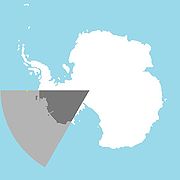 |
||
Historic claims
| Territory | Claimant | Date | Claim limits | ||
|---|---|---|---|---|---|
| New Swabia New Swabia New Swabia is a cartographic name sometimes given to an area of Antarctica between 20°E and 10°W in Queen Maud Land, which within Norway is administered as a Norwegian dependent territory under the Antarctic Treaty System... |
1939 | 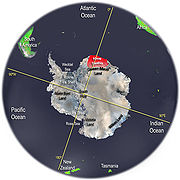 |
|||
| (Former protectorate of Germany Nazi Germany Nazi Germany , also known as the Third Reich , but officially called German Reich from 1933 to 1943 and Greater German Reich from 26 June 1943 onward, is the name commonly used to refer to the state of Germany from 1933 to 1945, when it was a totalitarian dictatorship ruled by... ) |
1945 | ||||
Possible future claims
There have been speculation about possible future claims. The US and RussiaRussia
Russia or , officially known as both Russia and the Russian Federation , is a country in northern Eurasia. It is a federal semi-presidential republic, comprising 83 federal subjects...
(as successor state
Succession of states
Succession of states is a theory and practice in international relations regarding the recognition and acceptance of a newly created sovereign state by other states, based on a perceived historical relationship the new state has with a prior state...
of the Soviet union
Soviet Union
The Soviet Union , officially the Union of Soviet Socialist Republics , was a constitutionally socialist state that existed in Eurasia between 1922 and 1991....
) have claimed to have reserved rights on claim and there have also been speculations on Brazil
Brazil
Brazil , officially the Federative Republic of Brazil , is the largest country in South America. It is the world's fifth largest country, both by geographical area and by population with over 192 million people...
making a claim bounded by 53° W
53rd meridian west
The meridian 53° west of Greenwich is a line of longitude that extends from the North Pole across the Arctic Ocean, Greenland, Newfoundland, the Atlantic Ocean, South America, the Southern Ocean, and Antarctica to the South Pole....
and 28° W
28th meridian west
The meridian 28° west of Greenwich is a line of longitude that extends from the North Pole across the Arctic Ocean, Greenland, the Atlantic Ocean, the Azores, the Southern Ocean, and Antarctica to the South Pole....
, overlapping thus with the Argentine and British claims but not with the Chilean.
Subantarctic island territories
Four island territories located north of the 60° South circle of latitudeCircle of latitude
A circle of latitude, on the Earth, is an imaginary east-west circle connecting all locations that share a given latitude...
are sometimes associated with the continent of Antarctica. None of these territories has an indigenous population.
Bouvet Island
Bouvet Island
Bouvet Island is an uninhabited Antarctic volcanic island in the South Atlantic Ocean, 2,525 km south-southwest of South Africa. It is a dependent territory of Norway and, lying north of 60°S latitude, is not subject to the Antarctic Treaty. The centre of the island is an ice-filled crater of an...
(Norwegian
Norway
Norway , officially the Kingdom of Norway, is a Nordic unitary constitutional monarchy whose territory comprises the western portion of the Scandinavian Peninsula, Jan Mayen, and the Arctic archipelago of Svalbard and Bouvet Island. Norway has a total area of and a population of about 4.9 million...
dependency)
 French Southern Territories Heard Island and McDonald IslandsHeard Island and McDonald IslandsThe Heard Island and McDonald Islands are an Australian external territory and volcanic group of barren Antarctic islands, about two-thirds of the way from Madagascar to Antarctica. The group's overall size is in area and it has of coastline...
French Southern Territories Heard Island and McDonald IslandsHeard Island and McDonald IslandsThe Heard Island and McDonald Islands are an Australian external territory and volcanic group of barren Antarctic islands, about two-thirds of the way from Madagascar to Antarctica. The group's overall size is in area and it has of coastline...
(Australian overseas territory) South Georgia and the South Sandwich Islands (British overseas territory)
South Georgia and the South Sandwich Islands (British overseas territory)
Antarctic Treaty

International relations
International relations is the study of relationships between countries, including the roles of states, inter-governmental organizations , international nongovernmental organizations , non-governmental organizations and multinational corporations...
with respect to Antarctica, Earth
Earth
Earth is the third planet from the Sun, and the densest and fifth-largest of the eight planets in the Solar System. It is also the largest of the Solar System's four terrestrial planets...
's only continent
Continent
A continent is one of several very large landmasses on Earth. They are generally identified by convention rather than any strict criteria, with seven regions commonly regarded as continents—they are : Asia, Africa, North America, South America, Antarctica, Europe, and Australia.Plate tectonics is...
without a native human population. The treaty has now been signed by 46 countries, including the United Kingdom, the United States, and the now-defunct Soviet Union
Soviet Union
The Soviet Union , officially the Union of Soviet Socialist Republics , was a constitutionally socialist state that existed in Eurasia between 1922 and 1991....
. The treaty set aside Antarctica as a scientific preserve, established freedom of scientific investigation and banned military activity on that continent
Military activity in the Antarctic
As Antarctica has never been permanently settled by humans, there has historically been little military activity in the Antarctic. While the Antarctic Treaty, which came into effect on June 23, 1961, bans military activity in Antarctica, military personnel and equipment may be used for scientific...
. This was the first arms control
Arms control
Arms control is an umbrella term for restrictions upon the development, production, stockpiling, proliferation, and usage of weapons, especially weapons of mass destruction...
agreement established during the Cold War
Cold War
The Cold War was the continuing state from roughly 1946 to 1991 of political conflict, military tension, proxy wars, and economic competition between the Communist World—primarily the Soviet Union and its satellite states and allies—and the powers of the Western world, primarily the United States...
. The Soviet Union and the United States both filed reservations against the restriction on new claims, and the United States and Russia
Russia
Russia or , officially known as both Russia and the Russian Federation , is a country in northern Eurasia. It is a federal semi-presidential republic, comprising 83 federal subjects...
assert their right to make claims in the future if they so choose. Brazil
Brazil
Brazil , officially the Federative Republic of Brazil , is the largest country in South America. It is the world's fifth largest country, both by geographical area and by population with over 192 million people...
maintains the Comandante Ferraz
Comandante Ferraz Brazilian Antarctic Base
The Comandante Ferraz Brazilian Antarctic Base is a Brazilian research station located in Admiralty Bay, King George Island, near the tip of the Antarctic Peninsula....
(the Brazilian Antarctic Base) and has proposed a theory to delimiting territories using meridians, which would give it and other countries a claim. In general, territorial claims below the 60° S
60th parallel south
The 60th parallel south is a circle of latitude that is 60 degrees south of the Earth's equatorial plane. No land lies on the parallel—it crosses nothing but ocean...
parallel have only been recognised among those countries making claims in the area. However, claims are often indicated on maps of Antarctica - this does not signify de jure recognition.
All claim areas except Peter I Island
Peter I Island
Peter I Island is an uninhabited volcanic island in the Bellingshausen Sea, from Antarctica. It is claimed as a dependency of Norway, and along with Queen Maud Land and Bouvet Island comprises one of the three Norwegian dependent territories in the Antarctic and sub-Antarctic. Peter I Island is ...
are sectors, the borders of which are defined by degrees of longitude
Longitude
Longitude is a geographic coordinate that specifies the east-west position of a point on the Earth's surface. It is an angular measurement, usually expressed in degrees, minutes and seconds, and denoted by the Greek letter lambda ....
. In terms of latitude
Latitude
In geography, the latitude of a location on the Earth is the angular distance of that location south or north of the Equator. The latitude is an angle, and is usually measured in degrees . The equator has a latitude of 0°, the North pole has a latitude of 90° north , and the South pole has a...
, the northern border of all sectors is the 60° S parallel which does not cut through any piece of land, continent or island, and is also the northern limit of the Antarctic Treaty. The southern border of all sectors collapses in one point, the South Pole
South Pole
The South Pole, also known as the Geographic South Pole or Terrestrial South Pole, is one of the two points where the Earth's axis of rotation intersects its surface. It is the southernmost point on the surface of the Earth and lies on the opposite side of the Earth from the North Pole...
. Only the Norwegian sector is an exception: the original claim of 1930 did not specify a northern or a southern limit, so that its territory is only defined by eastern and western limits.
The Antarctic Treaty states that contracting to the treaty:
- is not a renunciation of any previous territorial claim.
- does not affect the basis of claims made as a result of activities of the signatory nation within Antarctica.
- does not affect the rights of a State under customary international lawCustomary international lawCustomary international law are those aspects of international law that derive from custom. Along with general principles of law and treaties, custom is considered by the International Court of Justice, jurists, the United Nations, and its member states to be among the primary sources of...
to recognise (or refuse to recognise) any other territorial claim.
What the treaty does affect are new claims:
- No activities occurring after 1961 can be the basis of a territorial claim.
- No new claim can be made, except by the United StatesUnited StatesThe United States of America is a federal constitutional republic comprising fifty states and a federal district...
or then Soviet UnionSoviet UnionThe Soviet Union , officially the Union of Soviet Socialist Republics , was a constitutionally socialist state that existed in Eurasia between 1922 and 1991....
, now Russian Federation. - No claim can be enlarged.
See also
- Antarctic Treaty SystemAntarctic Treaty SystemThe Antarctic Treaty and related agreements, collectively called the Antarctic Treaty System or ATS, regulate international relations with respect to Antarctica, Earth's only continent without a native human population. For the purposes of the treaty system, Antarctica is defined as all of the land...
- Antarctica
- History of AntarcticaHistory of AntarcticaThe history of Antarctica emerges from early Western theories of a vast continent, known as Terra Australis, believed to exist in the far south of the globe...

